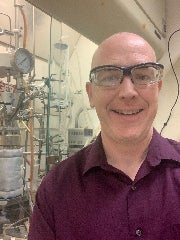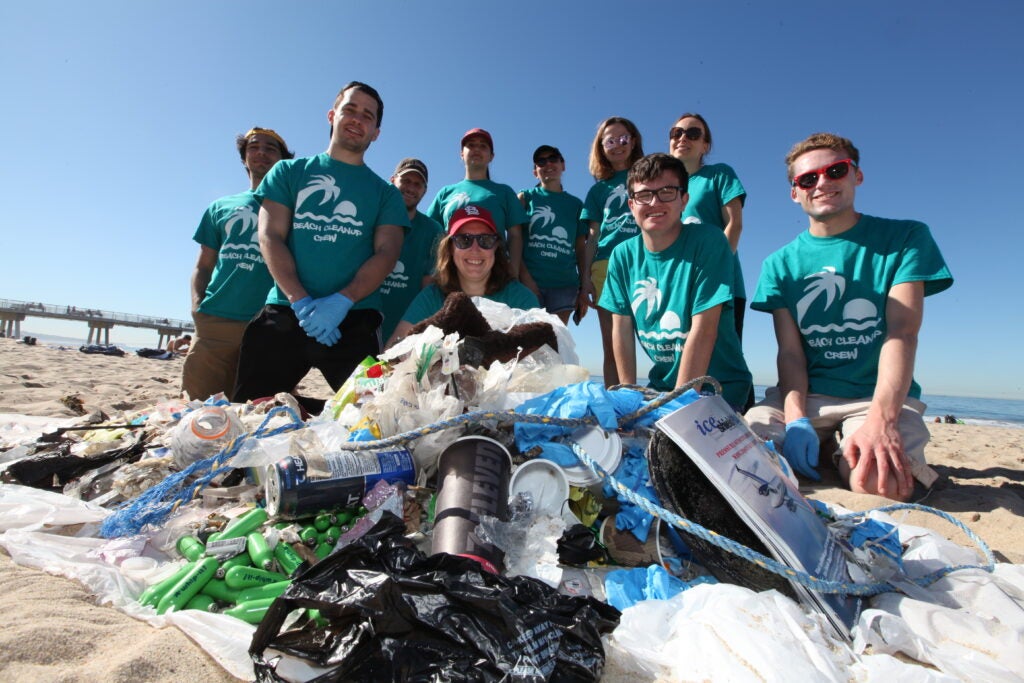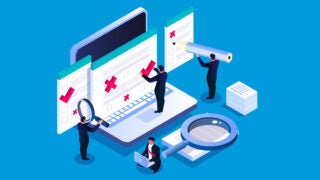“A good silicon solar cell is 20% efficient — 20% of the light hitting it is converted to electrical energy. But silicon can’t be made transparent. It also absorbs visible light, but it doesn’t absorb much infrared. With organic-based solar cells, we can design them to absorb strongly in the near infrared where there’s plenty of light that you can’t see. My group designs organic molecules that are designed for this application, and we’re working with collaborators at the University of Michigan who have developed a solar cell window coating that is 50% transparent and is still 10% efficient. It is a promising solution to achieve zero carbon.”
 “Resilience and sustainability are two of the great challenges facing human society. How do we manufacture new structures that can better resist and heal damage after extreme events? How do we design next-generation infrastructure that will be strengthened by harnessing carbon dioxide, but not weakened by greenhouse gases? Using state-of-the-art manufacturing methods, my research group fabricates materials and structures that mimic the microstructures and functions of natural structures.
“Resilience and sustainability are two of the great challenges facing human society. How do we manufacture new structures that can better resist and heal damage after extreme events? How do we design next-generation infrastructure that will be strengthened by harnessing carbon dioxide, but not weakened by greenhouse gases? Using state-of-the-art manufacturing methods, my research group fabricates materials and structures that mimic the microstructures and functions of natural structures.
“One place this technology might soon be available to consumers will be upcycling plastic waste into useful materials, such as furniture and construction materials. Another near-future technology will be negative-carbon-emission construction materials. The existing cement-based construction materials contribute to 8-10% of global carbon dioxide emissions. Developing new materials that can better resist and heal damages after extreme events will reduce negative environmental impacts — as well as the costs of replacing or repairing infrastructure.”
Qiming Wang is an expert in bioinspired manufacturing. He is the Stephen Schrank Early Career Chair in Civil and Environmental Engineering and an assistant professor of civil and environmental engineering at the USC Viterbi School of Engineering.
Contact: qimingw@usc.edu
 “In California, we’ve talked about the ‘hydrogen highway’ — what if you wanted to drive your car from L.A. to San Francisco in a hydrogen fuel cell vehicle… could you fill it? There’s hydrogen in Bakersfield, but there’s a dead zone all the way from there to the South Bay.
“In California, we’ve talked about the ‘hydrogen highway’ — what if you wanted to drive your car from L.A. to San Francisco in a hydrogen fuel cell vehicle… could you fill it? There’s hydrogen in Bakersfield, but there’s a dead zone all the way from there to the South Bay.
“I study catalysis, so I get into the nuts and bolts of how you store hydrogen in a liquid carrier, how you release hydrogen on site. The researchers at the Department of Energy think what we can do is take some liquid, hydrogenate it catalytically somewhere that’s hydrogen rich and then dehydrogenate it later where you need it, like a remote filling station. We’ve got a demo fuel unit (pictured at right) which we are developing — you could probably fill a little golf cart with it, but the proof of concept is there.”
Travis Williams is an expert in chemical analysis and cleantech. He is a professor of chemistry at USC Dornsife College of Letters, Arts and Sciences and a faculty affiliate at the USC Wrigley Institute for Environmental Studies.
Contact: travisw@usc.edu
4) Make processing for plastics safer to eliminate toxic byproducts
 “We need to address the plastics that are accumulating in the oceans. They’re very difficult to degrade. PVC, in particular, tends to release hydrochloric acid and other toxic products, whether it’s in the landfill or people try to recycle it. There are also a lot of plastics that have things that stay inside. For instance, BPA in polycarbonate plastics was a big craze a few years ago where everybody was very worried. That’s an example of a building block of plastic being left behind in those plastics.
“We need to address the plastics that are accumulating in the oceans. They’re very difficult to degrade. PVC, in particular, tends to release hydrochloric acid and other toxic products, whether it’s in the landfill or people try to recycle it. There are also a lot of plastics that have things that stay inside. For instance, BPA in polycarbonate plastics was a big craze a few years ago where everybody was very worried. That’s an example of a building block of plastic being left behind in those plastics.
“My research group’s goal is to make processing of PVC in the recycling centers more environmentally friendly. Utilizing catalysis, we chop up those plastics into small molecules or new plastics. Not only can we successfully recycle these plastics, but we can potentially create the plastic into a higher value product.”
Megan Fieser is an expert in inorganic chemistry, catalysis and degradable polymers. She is a Gabilan Assistant Professor of Chemistry at USC Dornsife College of Letters, Arts and Sciences and a faculty affiliate at the USC Wrigley Institute for Environmental Studies.
Contact: fieser@usc.edu
5) How you can help: Reduce your use of plastics
 “Microplastics are an emerging area of concern, with the most common microplastics found in coastal California waters being particles from tires, microfibers from synthetic fabrics and breakdown products from larger plastic litter. These plastics are less than 5 mm in size and are ubiquitous in the environment, but their impacts are much less understood because research on microplastic impacts is still in the early stages.
“Microplastics are an emerging area of concern, with the most common microplastics found in coastal California waters being particles from tires, microfibers from synthetic fabrics and breakdown products from larger plastic litter. These plastics are less than 5 mm in size and are ubiquitous in the environment, but their impacts are much less understood because research on microplastic impacts is still in the early stages.
“What can you do? The best way to reduce the impact of plastics in L.A.’s waters is to prevent the use of plastics in the first place! Whenever possible choose non-plastic alternatives like aluminum cans or bringing your own utensils instead of taking single-use options at restaurants. One way to reduce microplastics is to choose clothing made with natural fibers when possible. This problem will also require larger scale changes only possible through new policies and regulations, so lobbying your representatives to support plastic source reduction legislation is key.”
Jill Sohm is an expert on biological oceanography and microbial ecology. She is director and an associate professor of environmental studies at USC Dornsife College of Letters, Arts and Sciences and a faculty affiliate at the USC Wrigley Institute for Environmental Studies.
Contact: sohm@usc.edu
 “Resilience and sustainability are two of the great challenges facing human society. How do we manufacture new structures that can better resist and heal damage after extreme events? How do we design next-generation infrastructure that will be strengthened by harnessing carbon dioxide, but not weakened by greenhouse gases? Using state-of-the-art manufacturing methods, my research group fabricates materials and structures that mimic the microstructures and functions of natural structures.
“Resilience and sustainability are two of the great challenges facing human society. How do we manufacture new structures that can better resist and heal damage after extreme events? How do we design next-generation infrastructure that will be strengthened by harnessing carbon dioxide, but not weakened by greenhouse gases? Using state-of-the-art manufacturing methods, my research group fabricates materials and structures that mimic the microstructures and functions of natural structures.

 “If you’ve got a downtown skyscraper and you want to be zero carbon, there isn’t enough room on the roof to put on solar panels that are going to be useful. You’re going to need to cover the whole South facing side of the building with solar cells — and really it needs to be three sides — but anyone with a window on that side of the building is not going to be happy because they won’t have a window anymore.
“If you’ve got a downtown skyscraper and you want to be zero carbon, there isn’t enough room on the roof to put on solar panels that are going to be useful. You’re going to need to cover the whole South facing side of the building with solar cells — and really it needs to be three sides — but anyone with a window on that side of the building is not going to be happy because they won’t have a window anymore.
 “We need to address the plastics that are accumulating in the oceans. They’re very difficult to degrade. PVC, in particular, tends to release hydrochloric acid and other toxic products, whether it’s in the landfill or people try to recycle it. There are also a lot of plastics that have things that stay inside. For instance, BPA in polycarbonate plastics was a big craze a few years ago where everybody was very worried. That’s an example of a building block of plastic being left behind in those plastics.
“We need to address the plastics that are accumulating in the oceans. They’re very difficult to degrade. PVC, in particular, tends to release hydrochloric acid and other toxic products, whether it’s in the landfill or people try to recycle it. There are also a lot of plastics that have things that stay inside. For instance, BPA in polycarbonate plastics was a big craze a few years ago where everybody was very worried. That’s an example of a building block of plastic being left behind in those plastics. “Microplastics are an emerging area of concern, with the most common microplastics found in coastal California waters being particles from tires, microfibers from synthetic fabrics and breakdown products from larger plastic litter. These plastics are less than 5 mm in size and are ubiquitous in the environment, but their impacts are much less understood because research on microplastic impacts is still in the early stages.
“Microplastics are an emerging area of concern, with the most common microplastics found in coastal California waters being particles from tires, microfibers from synthetic fabrics and breakdown products from larger plastic litter. These plastics are less than 5 mm in size and are ubiquitous in the environment, but their impacts are much less understood because research on microplastic impacts is still in the early stages.

